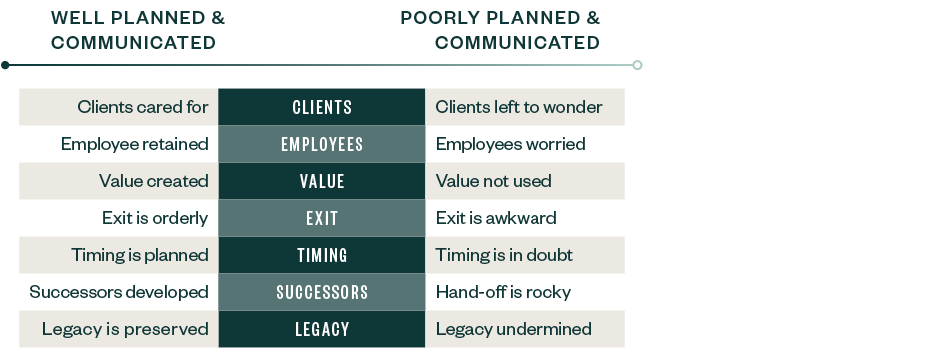
Every business is different, and so is every business leader. No matter what path you take to build and grow your company, there’s one milestone you’ll eventually approach: transitioning the leadership of your business to a successor.
Whether that successor is a family member, a member of your management group, or an outside candidate, succession is an event that affects your business, your family, your wealth, and your future.
Whether you’re thinking of transitioning leadership now or in 20 years, it helps to have a plan mapped out well in advance to help safeguard your business’s future.
What Is Management Succession Planning?
Management succession planning is a process of developing talent, systems, and strategies to help a business thrive when an owner or leader leaves the company. Management succession planning focuses on your people—defining management needs, identifying and selecting potential successor candidates, and growing your leadership pipeline.
Importance of Succession Planning
Proactively planning for management transition is critical to avoid undesirable results. Without a clear plan, your options may decrease over time, or you may be faced with an emergency transition when you or another member of your leadership team must unexpectedly exit the organization. The sooner planning begins, the greater the likelihood most, if not all, of your business and personal objectives will be met.
However, many business leaders avoid important succession issues because they touch on personally sensitive areas, such as family dynamics, retirement, and mortality. Often the result is an inadequate estate plan that reduces some future taxes but does little to fulfill the owner’s vision for their life or company.
Great succession planning empowers you to build a lasting legacy. It should also be comprehensive, considering all the needs of the business, the owner, and the family.
Succession Planning Process

Management Succession Process
In general, management succession planning involves a variety of steps, including:
Review and Clarify the Strategy of the Business
Depending on how your business is growing, there may be implications for what’s needed in a future leader. For example, if you have plans to expand your operations into international markets, it may be beneficial to select a successor who has related skills. Review and clarify the overarching strategy behind the organization to support relevant strategic goals during the leadership transition process.
Decide on an Ownership Transition Process
If you’re transitioning both leadership and ownership of the business, selecting the structure of the intended ownership transition will have critical implications for the rest of the management succession planning process.
Document the Timeline
Management succession planning often starts years in advance of a leadership transition. No matter what your needed timeline, clarify and document the key dates to help align all parties.
Management succession planning should ideally begin five or more years before an intended transition. This will provide ample time to identify potential successors or—if selecting from an internal roster of candidates—create growth and development plans to either prepare individual candidates or to stack your leadership bench with strong contenders.
Successful management succession planning can be done in as little as two or three years, but the shorter the timeframe, the more likely you are to run into challenges.
Once a goal date for the leadership transition is selected, stick to the timeline. Management succession processes can easily fall apart if all parties, including the incumbent leader, aren’t fully aligned and committed to the timeline.
Identify Core Leadership Qualifications
In reviewing the organization’s strategic goals, business needs, and current management team gaps, you can develop a list of core criteria to evaluate potential successors.
Identify Potential Successor Candidates
Your potential successor candidates will be determined by a variety of factors, including whether you are selecting an internal or external candidate. The goal is to have a slate of successor options who can be evaluated against the core leadership qualifications.
Leadership Transition
Once you’ve selected a successor candidate, develop a transition plan that outlines the key milestones, any onboarding or crossover time between roles, and the date by when all leadership responsibilities will be fully delegated.
Key Considerations for a Smooth Management Transition
Critical considerations for a smooth management transition include:
- Supporting current leaders and building your team
- Client, customer, and partner relationships
- Boards or advisory groups
- Embracing transparency
Supporting Current Leaders and Building Your Team
In addition to an organization’s CEO, an experienced and capable management team will allow for a smooth transition and is necessary for the business to carry on without missing a beat. Establishing a strong management team early in the pretransition process is crucial.
As part of succession planning, you may wish to delegate certain responsibilities, client relationships, or other critical roles to members of the management team who can provide consistency throughout the leadership transition process.
In addition, succession planning should also involve wholistically evaluating and enhancing efforts to strengthen your management team. In this way, succession planning isn’t about one single position, it’s about developing your entire internal leadership pipeline so the next time a leader leaves the organization, there’s a strong internal bench of candidates to step into that role.
Key External Relationships
If your business relies on deep client or partnership relationships, you must proactively determine how you’ll transition these relationships. Typically, this involves developing a plan for how, when, and to whom vital relationships will be transitioned. Clear and early communication can help create a smooth transition.
Boards or Advisory Groups
If your business has a board or works with an advisory group, it will be beneficial to engage these groups early in the process. Depending on your structure, the board may play a formal role in selecting a successor, but even if they don’t, they may provide helpful guidance, advice, and consistency throughout this process.
One key consideration is the need to strengthen relationships between your board and other members of your management team in advance of your departure. It can be helpful to consider whether there are any major upcoming board transitions, like turnover of the board chair, that you should consider in relation to the timeline.
Embracing Transparency
Open communication between the leadership team and a company’s employees and customers is central to a smooth, successful business transition.
During a business transaction, many employees worry about keeping their jobs, receiving the benefits they’ve come to expect, and continuing to have access to growth opportunities following the transition.
Because a company’s success depends on the quality of its employees and customers, most transaction due diligence typically focuses on determining methods for safeguarding the current and future stability of those two groups.
While leadership can’t guarantee the direction of future changes, being able to answer questions about equity, opportunity, and benefits can greatly reduce stressors for employees and customers transitioning with the business.
Once the leadership transition is announced, continue proactively instilling employee and customer confidence. To do this, leadership can communicate regularly with employees and customers, emphasizing that the quality of service won’t change, and that the transition is the next step for a strong future for the business.
We’re Here to Help
If there’s a business-transition in your future and you want a clear management succession plan, Moss Adams will provide a 30-minute consultation to discuss your needs. We can help you develop a practical playbook to drive success. To take the first step in your journey toward a management transition, contact your Moss Adams professional.